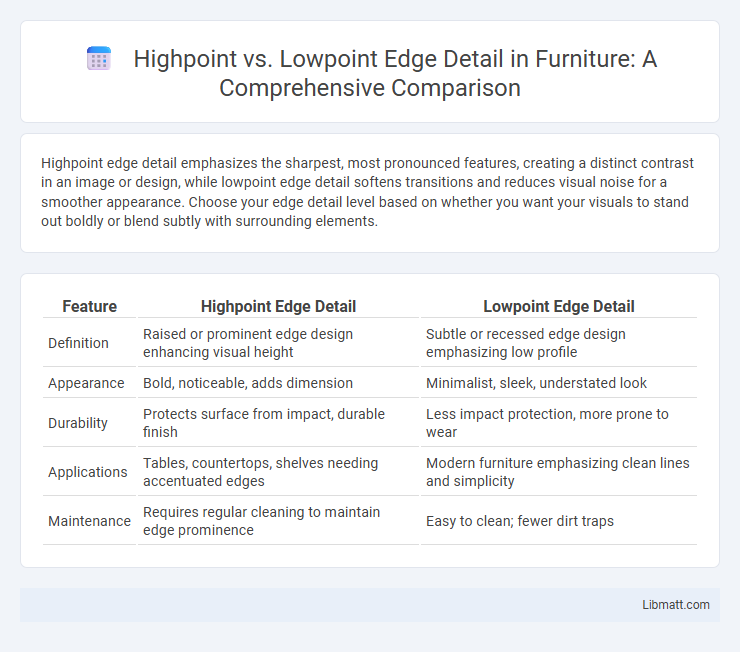Highpoint edge detail emphasizes the sharpest, most pronounced features, creating a distinct contrast in an image or design, while lowpoint edge detail softens transitions and reduces visual noise for a smoother appearance. Choose your edge detail level based on whether you want your visuals to stand out boldly or blend subtly with surrounding elements.
Table of Comparison
| Feature | Highpoint Edge Detail | Lowpoint Edge Detail |
|---|---|---|
| Definition | Raised or prominent edge design enhancing visual height | Subtle or recessed edge design emphasizing low profile |
| Appearance | Bold, noticeable, adds dimension | Minimalist, sleek, understated look |
| Durability | Protects surface from impact, durable finish | Less impact protection, more prone to wear |
| Applications | Tables, countertops, shelves needing accentuated edges | Modern furniture emphasizing clean lines and simplicity |
| Maintenance | Requires regular cleaning to maintain edge prominence | Easy to clean; fewer dirt traps |
Understanding Highpoint and Lowpoint Edge Detail
Highpoint edge detail refers to the distinct, sharp features on a surface where the highest elevation meets adjacent areas, crucial for defining texture and clarity in visual representations. Lowpoint edge detail captures the subtle contours at the lowest elevations or valleys, enhancing depth perception and realism in digital imaging or graphic design. Accurate differentiation between highpoint and lowpoint edges improves the overall quality of edge detection algorithms and image processing techniques.
Key Differences Between Highpoint and Lowpoint Edges
Highpoint edges feature elevated, sharper profiles that enhance traction and control on icy or steep terrain, making them ideal for expert skiers or snowboarders. Lowpoint edges, by contrast, have a more flattened, subtle angle designed for smoother, more forgiving turns, optimizing stability for beginners or intermediate riders. The key difference lies in the edge geometry: highpoint edges prioritize aggressive grip, while lowpoint edges emphasize ease of maneuverability and reduced edge catch.
Visual Impact of Edge Detailing Styles
Highpoint edge detailing offers a prominent, sharp profile that enhances the visual definition and modern appeal of your countertops or furniture. Lowpoint edge detailing features a subtle, rounded finish that creates a softer, more understated look ideal for minimalist or traditional designs. Choosing between highpoint and lowpoint edges significantly influences the overall aesthetic by balancing boldness with subtlety in your interior design.
Material Compatibility for Edge Detailing
Highpoint edge detail offers superior performance on hard materials like granite and quartz, providing sharp, clean edges that resist chipping. Lowpoint edge detail works best with softer surfaces such as laminate or solid surface materials, delivering smoother and more rounded finishes. Understanding your material's hardness ensures that your chosen edge detail enhances both durability and aesthetic appeal effectively.
Durability and Maintenance Considerations
Highpoint edge detail offers superior durability due to its thicker, reinforced design that resists chips and wear, making it ideal for high-traffic areas and heavy use. Lowpoint edges, while sleek and modern, tend to be more susceptible to damage and require careful maintenance to avoid nicks and cracks. Choosing the right edge detail like highpoint ensures your countertop sustains long-term functionality with minimal upkeep.
Design Applications of Highpoint Edge Detail
Highpoint edge detail offers a raised profile that enhances visual appeal and adds dimension to countertops, cabinetry, and furniture design. Your projects benefit from the sophisticated contour that highlights natural materials while providing a tactile sensory experience. This edge detail is ideal for contemporary kitchens and luxury interiors seeking a blend of function and style.
Common Uses for Lowpoint Edge Profiles
Lowpoint edge profiles are commonly used for kitchen countertops, bathroom vanities, and office desks due to their subtle, rounded design that reduces sharp edges and enhances safety. This edge detail is favored in residential and commercial spaces where a smooth, understated look is desired while maintaining durability. Its simple, low-profile shape also makes it easier to clean and less prone to chipping compared to elaborate edges.
Cost Implications of Edge Detail Selection
Highpoint edge details typically incur higher costs due to their sophisticated profiles and the additional labor required for fabrication and installation. Lowpoint edge details are more budget-friendly, offering simpler designs that reduce material waste and production time. Your choice between highpoint and lowpoint edge details directly impacts project expenses by balancing aesthetic appeal against cost efficiency.
Installation Tips for Highpoint and Lowpoint Edges
When installing highpoint edges, ensure precise alignment and secure anchoring to prevent grout gaps and maintain edge integrity. Lowpoint edges require careful leveling and drainage consideration to avoid water accumulation and potential damage. Your attention to these details enhances overall durability and aesthetic appeal in tile or countertop projects.
Choosing the Right Edge Detail for Your Project
Selecting the appropriate edge detail for your project depends on balancing aesthetics, functionality, and safety. Highpoint edges offer a sharp, defined look ideal for modern designs but may require extra care to prevent chipping and user injury. Lowpoint edges provide a softer, rounded finish that enhances durability and reduces the risk of damage while maintaining a sleek appearance.
highpoint vs lowpoint edge detail Infographic

 libmatt.com
libmatt.com